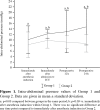Factors associated with increased intra-abdominal pressure in patients undergoing cardiac surgery
- PMID: 32175154
- PMCID: PMC7067007
- DOI: 10.5606/tgkdc.dergisi.2020.18662
Factors associated with increased intra-abdominal pressure in patients undergoing cardiac surgery
Abstract
Background: The aim of this study was to investigate the intra-abdominal pressure changes and risk factors associated with increased intra-abdominal pressure in patients undergoing cardiac surgery.
Methods: Between July 2016 and January 2017, a total of 100 patients (74 males, 26 females; mean age 55.9±14.3 years; range, 19 to 75 years) who underwent cardiac surgery under cardiopulmonary bypass were included in the study. Patients" data including demographic and clinical characteristics and intra- and postoperative data were recorded. Intra-abdominal pressure was measured via a urinary catheter after anesthesia induction, on admission to the intensive care unit, and at postoperative 12 and 24 h. The patients were divided into two groups according to the intraabdominal pressure as Group 1 (≥12 mmHg; n=49) and Group 2 (<12 mmHg; n=51).
Results: In the univariate regression analysis, high intra-abdominal pressure was related to intra-abdominal pressure measured after anesthesia induction (Odds Ratio =0.70, p=0.001), age (odds ratio=0.95, p=0.004), hypertension (odds ratio=4.51, p=0.0001), duration of cardiopulmonary bypass (odds ratio=0.97, p=0.0001), intraoperative lactate levels (odds ratio=0.53, p=0.0001), use of red blood cells (odds ratio=0.24, p=0.0001), use of dopamine (odds ratio=0.21, p=0.002), dobutamine (odds ratio=0.28, p=0.005), use of noradrenaline (odds ratio=0.25, p=0.016), postoperative lactate levels (odds ratio=0.60, p=0.0001), duration of cross-clamp (odds ratio=0.97, p=0.0001), atrial fibrillation (odds ratio=5.89, p=0.004), and acute kidney injury (odds ratio=8.33, p=0.048). In the multivariate analysis, the intra-abdominal pressure at baseline (odds ratio=0.70, p=0.045), age (odds ratio=0.93, p=0.032), hypertension (odds ratio=6.87, p=0.023), duration of cardiopulmonary bypass (odds ratio=0.98, p=0.062), intraoperative lactate levels (odds ratio=0.57, p=0.035), and use of red blood cells (odds ratio=0.19, p=0.003) remained statistically significant.
Conclusion: Our study results suggest that age, hypertension, duration of cardiopulmonary bypass, intraoperative lactate levels, and use of red blood cells are risk factors associated with elevated intra-abdominal pressure in patients undergoing cardiac surgery. Increased awareness of these risk factors and the addition of intra-abdominal pressure measurement to the standard follow-up scheme in patients with variable hemodynamics, low cardiac output, and high lactate levels in the intensive care unit may be useful in early diagnosis of complications and in decreasing morbidity.
Keywords: Cardiac surgery; cardiopulmonary bypass. intra-abdominal pressure; risk factor.
Copyright © 2020, Turkish Society of Cardiovascular Surgery.
Conflict of interest statement
Conflict of Interest: The authors declared no conflicts of interest with respect to the authorship and/or publication of this article.
Figures


References
-
- Maluso P, Olson J, Sarani B. Abdominal Compartment Hypertension and Abdominal Compartment Syndrome. Crit Care Clin. 2016;32:213–222. - PubMed
-
- Czajkowski M, Dabrowski W. Changes in intra-abdominal pressure during CABG with normovolemic hemodilution. CR487-92Med Sci Monit. 2006;12 - PubMed
-
- Dabrowski W. Changes in intra-abdominal pressure and central venous and brain venous blood pressure in patients during extracorporeal circulation. CR548-54Med Sci Monit. 2007;13 - PubMed
-
- Dabrowski W, Rzecki Z. Intra-abdominal and abdominal perfusion pressure in patients undergoing coronary artery bypass graft surgery. Acta Clin Belg. 2009;64:216–224. - PubMed
LinkOut - more resources
Full Text Sources
